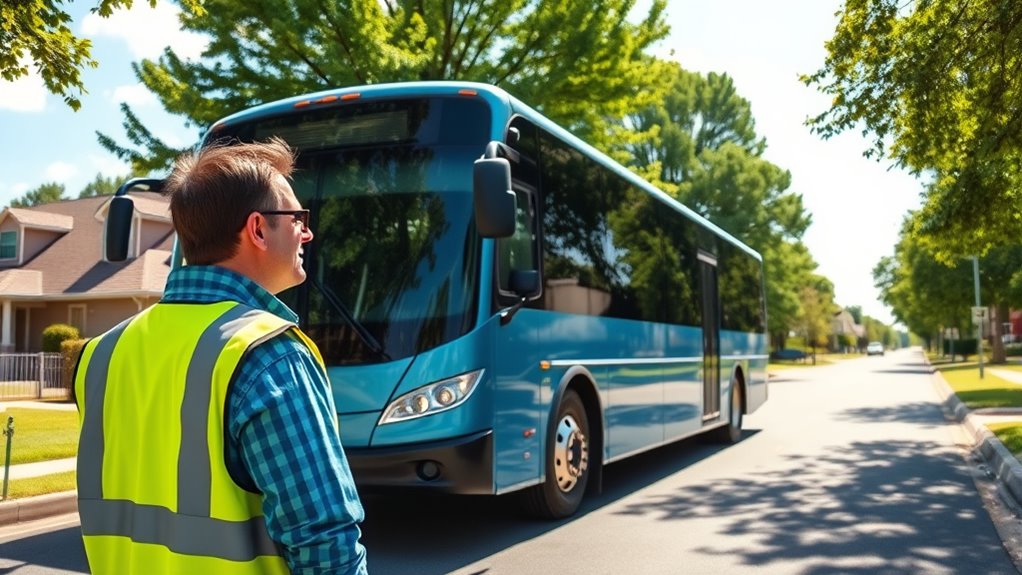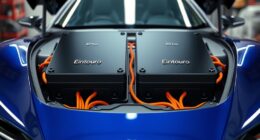Your journey from skepticism to advocacy begins as you learn to navigate new systems and charging routines. With proper training and support, you become confident handling electric buses’ features, like regenerative braking and battery management. As you experience the quieter rides and environmental benefits, your perception shifts. Over time, managing the charging schedule and gaining hands-on experience transform doubts into enthusiasm. Keep exploring, and you’ll discover how this change can be rewarding for your career and community.
Key Takeaways
- Hands-on training and site visits help drivers become comfortable with charging processes and vehicle features.
- Gaining experience with the smooth operation and quiet ride of electric buses shifts perceptions positively.
- Understanding safety protocols and troubleshooting builds confidence and trust in electric bus technology.
- Supportive infrastructure and routine integration ease the initial learning curve and reduce skepticism.
- Positive experiences and peer sharing transform drivers from skeptics to advocates for electric buses.

Switching to electric school buses can be a significant change for drivers, often challenging their comfort with traditional diesel models. The shift isn’t just about adapting to quieter engines or new driving techniques; it involves understanding new systems and adjusting your routine. One of the biggest hurdles is getting familiar with the charging infrastructure. Unlike diesel refueling, which is quick and familiar, charging stations require planning and patience. You need to know where the chargers are located, how long it takes to fully charge, and how to manage your routes around charging schedules. Initially, this can seem intimidating, especially if you’re used to filling up in minutes and hitting the road. But with proper driver training, you learn to see these stations as an integral part of your daily routine rather than an obstacle. Training programs often include site visits, demonstrations, and hands-on practice that demystify the charging process. You discover that charging can be integrated smoothly into your schedule, especially with smart planning and access to fast chargers. As you become more comfortable with the infrastructure, the process feels less like an obstacle and more like a routine part of your day.
Beyond the technical aspect, driver training also covers vehicle operation, safety protocols, and troubleshooting. This extensive approach helps you develop confidence behind the wheel of an electric bus, dispelling initial skepticism. You learn how to handle the vehicle’s unique features, such as regenerative braking and battery management systems, which can seem unfamiliar at first. The training also emphasizes safety, ensuring you’re prepared for any issues that might arise with charging or vehicle operation. Understanding how to monitor and maintain the battery management systems is crucial for optimal performance and safety. Over time, as you gain experience, you start to appreciate the benefits—quieter rides, smoother acceleration, and reduced emissions—that electric buses bring to your daily routes. Your perspective shifts from seeing the change as a challenge to viewing it as an opportunity for growth and contribution to a cleaner environment.
In the beginning, it may feel like a steep learning curve, but the right training and infrastructure support make a significant difference. As you become more adept at managing charging schedules and understanding the vehicle’s capabilities, your confidence grows. You begin to advocate for electric buses, sharing your positive experiences with colleagues and school administrators. What once seemed like an intimidating transition now feels like a rewarding evolution in your driving career. With each successful route, you realize that embracing this change not only improves your skills but also helps shape a more sustainable future for your community.
Frequently Asked Questions
What Are the Long-Term Cost Savings of Electric School Buses?
You’ll see significant long-term cost savings with electric school buses through lower fuel and maintenance expenses. Conducting a thorough cost analysis helps you understand these benefits and plan your budget effectively. Electric buses have fewer moving parts, which means reduced repairs and downtime. Over their lifespan, these savings make electric buses a smart investment, helping you allocate resources more efficiently and support sustainable transportation initiatives.
How Do Electric Buses Perform in Extreme Weather Conditions?
Electric buses generally handle extreme weather well, but battery performance can decline in winter, affecting range and efficiency. You might notice reduced winter operation capabilities, especially during the coldest days. To mitigate this, guarantee proper battery insulation and preconditioning. With these measures, you’ll find electric buses reliable even in harsh conditions, maintaining safety and performance, and ultimately making winter operation manageable for your fleet.
Are There Sufficient Charging Stations for Daily Routes?
Yes, there are enough charging stations to support daily routes, thanks to improved charging infrastructure. Station accessibility has increased, making it easier for you to find nearby chargers easily. Many areas now have strategically placed stations that ensure your electric bus can recharge quickly between routes. This reliable charging infrastructure helps you stay on schedule and reduces concerns about running out of power, making electric buses a practical choice for daily operations.
What Safety Features Differentiate Electric Buses From Traditional Models?
Did you know electric buses often come equipped with advanced autonomous features? These innovations enhance passenger safety by reducing human error and improving navigation in traffic. Electric buses also feature reinforced structures and cutting-edge safety systems like collision avoidance technology. These elements work together to provide a safer environment for students and drivers alike, making electric buses a smarter, more secure choice compared to traditional models.
How Do Maintenance Requirements Compare Between Electric and Diesel Buses?
You’ll find that electric buses generally require less maintenance than diesel models, mainly because they have fewer moving parts. Battery maintenance is essential, but it’s straightforward, involving regular checks and timely charging. Repair complexity is lower since electric systems are simpler and often need fewer repairs. Overall, electric buses can save you time and money on maintenance, making them a more reliable and cost-effective option for your fleet.
Conclusion
As you watch these electric buses hit the road each morning, you might wonder what changed your perspective. Could it be the quiet hum, the savings, or something else entirely? One thing’s for sure—your journey from skeptic to advocate isn’t over. There’s more to discover, more challenges to face, and a future that’s waiting to be shaped. Are you ready to see what comes next? The road ahead might surprise you.









